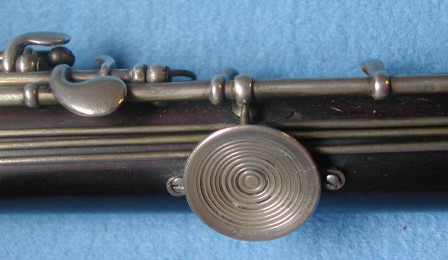Heh heh, I think I can assert with confidence, that if you don’t see the benefits of the three-point hold, you aren’t doing it right! I’ll concede it took me a long time to get it right - I don’t think the period instructions are altogether helpful. I found I had to turn the head back in a long way to be able to find the magical balance point - the point where you can go to ooo ooo from any other fingering and don’t find the embouchure twisting towards you.
And, having got to the right geometry, I don’t find any need for holding the flute up - pinned between the chin, the LH 1 knuckle pushing it in, and the right thumb tip pushing it out, it can’t possibly fall down! And the benefits are many:
- the left thumb can wave around in the air, and is certainly free to press the Bb key
- RH4 can also wave around in the air and is free to press the Eb key
- the right hand fingers are straighter and can move more freely than with the more typical hold.
Now, as you are possibly aware, I disdain the descriptor “Rockstro Grip”, for what I think are two good reasons. Firstly, you tend to name things after their inventor, not after one of their last advocates. Rockstro makes it very clear he didn’t invent it - he even publishes a list of authorities who advocated it before him. Secondly, the word “grip” implies tightness to me. “The death grip”. Once you get this hold working properly, it’s remarkable how you can relax the pressure. And that’s important to keep our hands relaxed, healthy and free.
Now, one of the things that puzzled me about Rockstro advocating this hold is that by the time he was writing his book (released in 1890), the old flute had been superceded by the Boehm cylindrical flute (patented in 1847) or the flood of variants that followed it (including Rockstro’s own short-lived minor variant). The new flutes with their mechanised keywork were so much easier to hold and finger, so why on earth would Rockstro be continuing to recommend the hold that had been used by its predecessor? So I just unearthed my old Armstrong Boehm flute from the Cupboard of Death and tried it out using the 19th century flute hold. Brilliant! The benefits above still apply. Suddenly I can understand Rockstro - he would already be used to the three-point hold from his younger days playing the old flute. Even though the new flute didn’t really need it, why drop something that works so well? Hence his enthusiastic advocacy.
Indeed (and this was initially perplexing!), whereas I said above how I have to turn the head in a long way on my flute or on period flutes, I find I don’t have to turn it in much at all to be able to hold it in balance with the three points. Weird or what? Thinking about it, I think it must be because of the eccentric nature of the head. With our style of flutes, the bottom of the head strikes my bony chin, and has to be allowed for. With the Boehm style head, that bottom area is cut away, so no interference. I’ll be interested to hear from others on that topic.
But it gets more interesting. If I do turn the head right in on the Boehm, I also get the hard dark tone that we so lust after. I wonder if Rockstro was also lusting after that?
